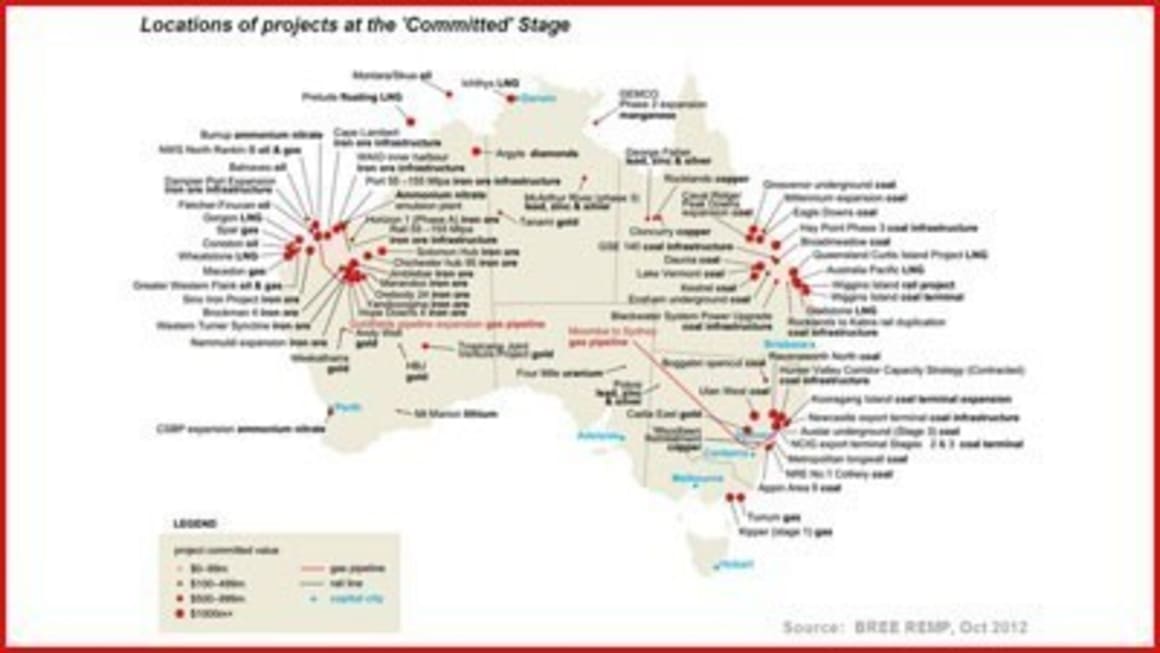Just 11 resources mega projects propping up mining boom: Tim Lawless

With the mining sector and commodity prices such a topical issue at the moment (for all the wrong reasons), it’s worthwhile having a look at the latest statistics regarding Australia’s resources and energy sector. As you can see from the Reserve Bank’s ‘Commodity Price Index’ below, non-rural commodity prices are down 21.6% since peaking in July 2011 (the non-rural component of the index includes prices for base metals and other resources, while rural commodities include agricultural items).
Click to enlargeThe fall in commodity prices is one of the primary reasons why Australia’s terms of trade (the ratio of export prices to import prices) have peaked, as can be seen in the graph below (taken directly from the RBA’s latest Statement on Monetary Policy). While the fall in commodity prices and the terms of trade appears to be quite glum news, look at how high the indicators are compared to their long-term average. Despite falling by nearly 22%, the non-rural component of the Commodity Price Index remains 125% higher than the long-term average.
Click to enlargeThe slowdown in commodity prices can be tied back to the slowdown in the Chinese economy, where economic growth has moderated from around 15% pre-GFC and will likely end the 2012 year around 7.5%, according to the OECD. The OECD is also projecting an improvement in Chinese economic growth over 2013, with a growth forecast of 8.5%, suggesting we are likely to see at least a stabilisation in Chinese resources demand, if not some level of growth.
With so much riding on the mining sector, the release of the Bureau of Resources and Energy Economics (BREE) ‘Resources and Energy Major Projects’ publication last week provides a timely update on key economic variables and the investment pipeline for the sector. The latest update from BREE highlights the changing landscape for resources and energy-related projects; there are 11 fewer committed projects in the pipeline since April 2012 (due to some projects being completed), however the value of committed projects has increased by around $8 billion, which is an historic high.
Click to enlargeAnother key point from the report is the significant proportion of projects which are classified as ‘mega projects’, i.e. those projects worth at least $5 billion. There are 11 mega projects at the committed stage, which account for 76%, or $201 billion of the total value of currently committed projects.
Click to enlargeFurther to this, the vast majority of mega projects relate to projects involved with the liquefied natural gas (LNG) sector, as can be seen in the graph below, accounting for the top seven most significant committed investment projects.
Australian resources projects have a lot riding on the natural gas sector at a time when price pressures from the oil and gas industry in the US have been seen a significant competitive intensification and will likely place further downwards pressure on gas prices internationally. At the same time there have been local cost blowouts which are causing the industry to be increasingly uncompetitive on the world stage. According to BREE, the cost increases are related to skilled labour shortages, the high Australian dollar, and transport costs, as well as some scope creep across the projects.
Click to enlargeClearly, the resources sector has some challenging times ahead, and there will be subsequent headwinds faced by Australia’s economic prosperity; it’s no wonder the Reserve Bank are looking towards other industry sectors to fill the economic hole that is being left by the downturn in the resources sector. While the news appears to be pretty glum across the resources sector, the downshift is coming from an ultra-high base and there is still a huge amount of resources projects that remain committed to, as can be seen in the map from the BREE report below.
Click to enlargeTim Lawless is national research director of RP Data.





